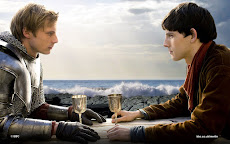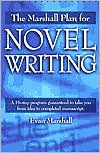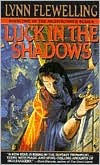Saturday, January 19, 2008
Editing the Novel
I posted a hypothetical "how to edit" piece on my TIPS & TRICKS blog some time ago, before actually attempting to edit a full-length manuscript. I included a disclaimer that warned readers I had never attempted to follow my own advice. The purpose of writing the piece was not to tell people how to do something that I didn't know how to do, but to put myself through the paces of trying to anticipate how I might actually go about it, since I was about to embark on a major editing effort at that time. Since then, I've had the fine pleasure of writing additional complete drafts and also reworking full-length novels and editing them. I've learned a little bit more than I knew before, and want to share a glimpse into the EDITING PROCESS as I experience it. Here goes....
There are three types of editing: story-level, scene-level and text-level. I'll tackle them one at a time.
1. STORY-LEVEL EDITING.
This is the highest-level editing, the one with the view to the entire story. It involves reviewing your overall plan for the story and figuring out whether what you wrote accomplishes that. This is where you figure out whether the ending works, whether a given scene is necessary, whether you adequately set up something or just dropped it on the reader. This is where you look for opportunities to work in more foreshadowing, where you raise questions and leave them to be answered later, creating suspense. You decide whether a given sequence is a relevant sub-plot or whether it ventures too far afield of your main plot, failing to contribute to the development of the themes or major threads. You realize you now possess a deeper level of understanding about your characters, the situation they're in, and their motivations. You gained this understanding while writing a complete draft. You use this understanding to draw out a stronger sense of the characters' motivations and the cause-and-effect aspect of the chain of events for the Reader, who will also appreciate seeing these connections. You also determine whether any new developments that came up in the writing are worth keeping, even if it means changes to your original plan. You have to negotiate with yourself on this, and it can be tough.
I think of this type of editing as reworking the story, more akin to planning and writing the story than editing the story. In fact, I don't really think of it as editing at all, even though it is a form of editing. This is what I do after completing a draft. If what I wrote works overall and needs only a few relatively minor changes, then I use this type of editing (or rethinking) to help me change individual scenes or chapters. If the changes needed are substantial, then I just do a complete rewrite, which is much easier than trying to fix something that is seriously broken. I enjoy this type of editing to a point, since I enjoy plotting. However, sometimes this gets frustrating, usually because I realize I have to make a decision that I don't want to make (should the story go this way or that way...). Overall, this sort of stuff is fun. At least, it can be. I work actively to keep it that way.
2. SCENE-LEVEL EDITING. This type of editing involves making changes to scenes to help them accomplish their business. When I realize from the story level that I need to add a certain piece of story information to a given scene, this is the point where I do that. If I need an outcome of a scene to be different in order for things to work better for the overall plot, then this is where I do that. My focus here is not so much on the actual words in the scene (that's the next level of editing), but on making the scene itself work properly. I take whatever insights I have and work them into the reality of the scene, its particulars, its specifics. I make sure I can see clearly where the beginning of the scene is, its middle and its ending, and what the point of it is.
The main thing I do in scene-level editing is tighten the focus. I make sure the POV character has a clear goal at the outset and makes a decision or two so that he/she takes an active role in doing things. I make sure the scene ends with a clear sense of how things turned out and that the ending of the scene implies or states directly a new question or direction to go in -- scenes must lead from one to the next, and where possible should increase suspense. Not all scenes have to have a major cliffhanger for an ending, but they should all have an emotional impact and/or new question that Readers will notice.
3. TEXT-LEVEL EDITING.
I tend to do text-level editing at all times. Every time I reread I change a word here or there. Every time I go through the story, I find myself fixing little things. Many little fixes over time add up to an awful lot of fixes. The enhancements make a difference, make the story more readable, makes it flow smoothly. I do this so much that I have to make it a point to shut off the text-level editor within me so I can focus on scene or story issues when I need to, or when I just want to read to catch the flow of the story over a longer sequence.
Text-level editing is where I find a more suitable word or phrase, where I break a long sentence down into several short sentences, where I take two short sentences and join them together, where I get rid of "and" and other words I find myself overusing from time to time, where I change -ing forms into -ed forms, where I get rid of "had" to simplify past tenses, where I get rid of "he said" or "she said" as much as possible, etc., etc.
I love this type of editing and now that I've done so much of it I've gotten really good at. I see new ways to consolidate and clarify text that I never dreamed possible before, a higher-level of editing skill -- and I was always a good editor to begin with, a "natural" at it. To learn more about this, I strongly recommend Evan Marshall's book, THE MARSHALL PLAN. The book features concrete examples. Before reading it, I had already learned a lot from reading best-selling authors. I noticed how they had a common style in structural terms that kept their prose readable. THE MARSHALL PLAN helped me bring those impressions together and create a conscious awareness and clear perspective on editing for clarity as it relates to novel writing.
In the near future, I'll post two more entries on my blog about editing. They will focus on scene-level editing and text-level editing, providing examples.
Since story-level editing involves whole stories, and I don't want to give away too much about my plots, I won't post examples of story-level editing. However, basic story planning is what's behind this type of editing -- having a sense of how to outline a story. For more ideas on that, see THE GAY MAN'S GUIDE TO WRITING FANTASY FICTION.
Adrian
Subscribe to:
Post Comments (Atom)








No comments:
Post a Comment